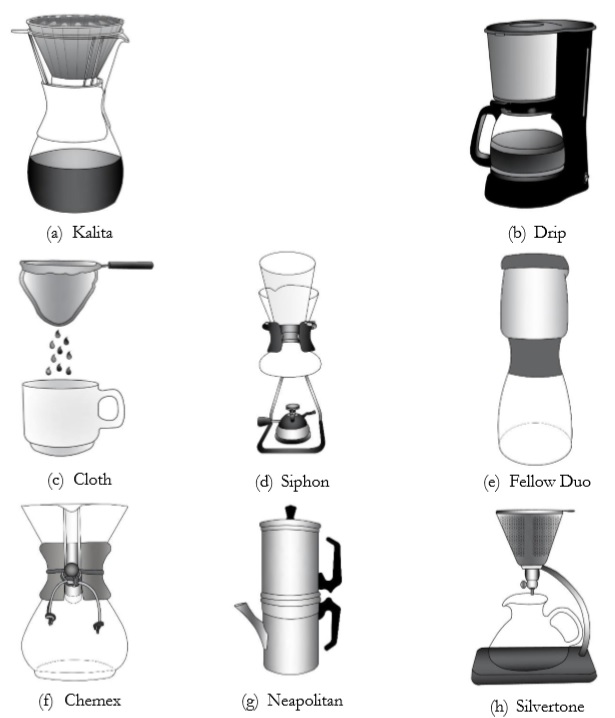Introduction
Coffee is among the most in-demand agricultural products worldwide (Liang et al., 2016; Maskell et al., 2021). A good cup profile depends upon climatic factors and operational conditions for the yield, fermentation, and roasting parameters and the variety, origin, and composition of the processed coffee (De Bruyn et al., 2017).
Various authors have indicated the functional aspects of certain coffee varieties and the role of certain foods, recommending their continuous consumption for health benefits (Aguiar et al., 2016; Oroian & Escriche, 2015). Additionally, with the Maillard reaction, roasting produces antioxidant substances with anti-radical activity, which is attributed to coffee’s phenolic component content (Moreira et al., 2017). Phenolic components act as antioxidants by way of single electron transfer (SET) and hydrogen atom transfer (HAT) (Ormaza-Zapata et al., 2020). Numerous studies have noted the role of phenolic compounds, flavonoids, tannins, and hydroxycinnamic acids, such as chlorogenic acid and ferulic acid, in chemical reactions that occur mainly during the roasting process. During preparation, these can modify the cup profile and have shown, using sensorial analysis, that coffee antioxidants also help highlight the most representative flavors in the final infusion (Lee et al., 2015; Sunarharum et al., 2014).
Barista culture has generated an emergent market for diverse coffee preparations, supported by the principles of preparation, creativity, and ingenuity of coffee connoisseurs and lovers. Each preparation is characterized by unique sensorial profiles and compositions in terms of antioxidant compounds, following the method used (Angeloni et al., 2019; Ormaza-Zapata et al., 2020). Barism also stimulates special coffee consumption; with names of origin and the development of emerging methods for preparing new and exotic beverages, value is added to coffee-derived products (Angeloni et al., 2019).
Gravity-filtration methods are characterized by the passage of coffee through semi-permeable structures (cloth, paper, or wire mesh) to dose the coffee extraction that falls by gravity, while coffee and 90 °C hot water are in contact. This process results in a coffee beverage through lixiviation-filtration. The filter type influences the retention of antioxidant compounds and their anti-radical activity in the use of cloth (cloth filter, siphon), wire mesh (Fellow Duo, Silvertone, Neapolitan), or paper (Chemex, Kalita, Drip), given that these metabolites may remain trapped in the insoluble part of coffee, and modify antioxidant content, and consequently, antioxidant activity. Except for the Silvertone method, they have short contact times; however, the Silvertone method has tiny pore sizes in its wire mesh filter. Variables such as contact time, the coffee/water relationship, and filter type influence, both positively and negatively, metabolite composition and antioxidant activity (Liang & Kitts, 2014; Liang et al., 2016).
Previous studies (e.g., Çelik & Gökmen, 2018; Muñoz et al., 2020) have not considered forms of preparation, only the popularity of said preparations. The present study relates the preparation principle to the composition of various antioxidant compounds and the evaluation of the corresponding cup profiles by expert coffee tasters (Angeloni et al., 2019). The objective hereof was to determine antioxidant retention and capacity and develop cup profiles for UGQ (usual good quality) coffee during the preparation of coffee-based beverages via eight gravity-filtration methods. The antioxidant compounds studied were as follows: total phenols, flavonoids, condensed tannins, and hydroxycinnamic phenolic acids (chlorogenic acid, caffeic acid, p- coumaric acid, and ferulic acid). Antioxidant activity was evaluated using the ABTS (antioxidant capacity of the cationic radical 2,2-Azino-bis-3-ethylbenzthiazoline-6-sulfonic acid), ORAC (Oxygen Radical Absorption Capacity), and FRAP (Ferric Reducing Antioxidant Power) methods.
Materials and Methods
Raw Materials
Parchment coffee (Coffea arabica L. var. Castillo) was used. It is cultivated in the municipality of Anserma, Caldas, Colombia. It hails from the “San Rafael” farm, located at 1,750 m a.s.l. Crop conditions were 20 °C, with an average relative humidity of 72 %; 1,200 g of each sample were analyzed for all the procedures (Díaz-Arango et al., 2018).
Physicochemical Analyses
Green coffee beans were first threshed (Quantik, CR-2000, Armenia, Colombia) and sifted (NTC 5248, 2013). Coffee retained on the 14/64-inch mesh, called Excelso UGQ, was used for all analyses. The smaller beans were removed, as were other defective beans (Group I means the defects that affect the cup, and Group II means the defects that affect the bean’s physical appearance). The humidity content of green coffee was determined via gravimetry on a stove (Dies, TH115FM, Antioquia, Colombia). It was roasted at 180 °C and 100 % power in a laboratory-scale roaster (Quantik, TC-150 A/R, Armenia, Colombia) until obtaining medium- roast beans The roaster has a capacity for 100 g of coffee beans. The roasted coffee was ground (Grindmaster 810, Mexico) according to the preparation types of the beverage selected for this study
Coffee Beverage Preparation by Gravity-Filtration Methods
Eight coffee beverage preparation methods were evaluated (figure 1) using the gravity-filtration principle between roasted, ground coffee, and water, at a given temperature, . The procedure for each method is described below.
Kalita
Medium-ground (526 microns) roasted coffee was used. Contact time with the 90 °C hot water totaled four minutes. We mixed exactly 14 g of coffee with 150 mL of water. The Kalita paper filter (wave #185-white) was placed inside of the glass cone, in the upper part of the coffee container, water was added, and the filtration process occurred.
Drip Coffee Maker
Medium-ground (526 microns) roasted coffee was used. For extraction, a paper filter was employed according to drip coffee maker dimensions. We used exactly 21 g of roasted ground coffee in 225 mL of hot water (90 °C). Contact time coffee-water) was three minutes
Cloth Filter
We mixed exactly 21 g of medium-ground coffee (526 microns) with 225 mL of hot water (90 °C). The coffee was placed inside the cloth filter, hot water was added to the cloth filter, and extraction occurred. The extraction time was one minute.
Japanese Siphon
It is known as a vacuum coffee maker. The water was deposited in the round-bottom container over the burner. The coffee was placed in a glass funnel with a cloth filter and over the container. The burner was lit. The water boiled in the container, rose to the funnel, and entered into contact with the roasted, ground coffee. The coffee was mixed manually with a spoon, and the water rose to funnel level for one minute. The coffee was then wholly prepared but still contained grounds. The container was taken off the flame, cooled, and the coffee prepared fell through the cloth filter in the funnel and into the container. The coffee was then ready for consumption. We mixed exactly 21 g of medium-ground coffee (526 microns) and 225 mL of hot water at the boiling point (93 °C).
Fellow Duo
The roasted ground coffee and hot water were placed in the metallic container in the upper filter, or mesh metallic filter. With this preparation method, the upper container may be turned (it only has two graduated positions) per the degree of extraction desired to obtain a more concentrated or weaker beverage. For this experiment, it was turned to obtain a more concentrated beverage. Following four minutes of contact, it was filtered by gravity and fell to the glass container below, ready for consumption. We mixed exactly 21 g of medium-ground coffee (526 microns) and 225 mL of hot water (90 °C).
Chemex
Medium-ground (526 microns) roasted coffee was used. We mixed exactly 14 g of coffee with 150 mL of water. Contact time with the hot water (90 °C) was four minutes. The coffee was placed inside the Chemex FS-100 paper filter, inside the glass cone in the upper part of the container, hot water was added, and the filtration process occurred.
Neapolitan
This method consists of a coffee maker with two reservoirs: one above and another with a screw mechanism, so that they may be treated as a single unit. Each reservoir has a handle to manipulate the container. Once the coffee maker was unscrewed, we put water in the lower container, characterized by its serving spout. It was filled with water only to the valve. The filter was placed over the lower container, adding roasted ground coffee. The upper part was secured by screwing it to the lower part. The coffee maker was placed on the flame with the water-containing part below. When the water began to boil, the coffee maker was turned over. Both handles were gripped, and the coffee maker rapidly turned such that the water would fall through the filter and begin to enter the lower area. After two minutes, the water filtered through the ground coffee, and the beverage was present in the lower container, ready to be served with the spout for said purpose. We mixed exactly 14 g of medium-ground roasted coffee (526 microns) and 150 mL of hot water.
Silvertone
This method consists of a metallic filter with numerous holes into which roasted, ground coffee was placed. The metallic filter goes over fixed support to facilitate the coffee infusion process. Coffee-water contact time was 45 minutes. We used 14 g of roasted, medium-ground (526 microns) coffee with 150 mL of hot water (90 °C) for this preparation.
We verified grind particle size with the Taylor series (NTC 2441, 2011). Soluble solids or °Brix were determined with a digital refractometer (PAL-1, Atago®, Japan). Beverage pH was determined via potentiometry (Lab-850; Schott Instruments®, Germany). For each preparation method studied, we evaluated the weight of the ground coffee and that of the beverage with a precision scale (Fénix-Plus, Bogota, Colombia). Extraction Performance (%) was calculated for each beverage according to Equation (1). Samples were hermetically sealed in polypropylene plastic jars and stored at a temperature of -40 °C prior to analysis (Díaz-Arango et al., 2018).
Where m1 is the weight, in g, of the ground roasted coffee; m2 is the weight, in g, of the total beverage obtained; and °Brix is the percentage, in soluble solids, of the drink.
Profile Analysis of Coffee Beverage Cup
The beverages obtained by those gravity-filtration methods studied were tasted with the QDA (Quantitative Descriptive Analysis) flavor profile in mind. Three expert tasters scored each beverage. The attributes evaluated in each sample were as follows: fragrance, aroma, acidity, bitterness, body, and overall impression. Additional descriptors were also considered in the cup test for each beverage to identify their defects, such as acrid, vinegar, fermented, astringent, stagnant, rancid, phenolic, earthy, and chemical tastes, among others. QDA test results were represented as averages and radial plots (NTC 3566, 2011). Each expert taster was Q Grader certified.
Sample Preparation
The beverages prepared with the eight evaluated methods were diluted with distilled water in fixed concentrations (LabTech, Italy) between 1 and 10 % to ascertain antioxidant content and activity (Rojano et al., 2015).
Total Phenol Determination
We performed this analysis with Follin-Ciocalteu’s colorimetric method. A curve pattern was created, using gallic acid as a standard. Total phenol content was expressed as mg of gallic acid/100 g of sample. A UV-VIS spectrophotometer (Jenway, 6405, Essex, England) was employed, taking readings in triplicate, at 760 nm. The Follin-Ciocalteu reagent and gallic acid were obtained from the Merck trading house (Germany) (Ormaza-Zapata et al., 2019).
Total Flavonoid Content
One aliquot of 0.5 mL of beverage sample solution was taken, adding 0.5 mL of aluminum chloride AlCl3 and 2 % ethanolic solution. The mixture was left to incubate at room temperature. The absorbency of each sample was determined at a wavelength of 420 nm. Catechin solutions (Sigma-Aldrich®, USA) between 5-25 µg/mL were used with ethanol and aluminum chloride (Merck, Germany), to construct the calibration curve, with a purity of 97.5 %. We calculated the results obtained as equivalent mg of catechin/100 g of sample. Tests were performed in triplicate using an UV-VIS spectrophotometer (Jenway, 6405, Essex, England) (Díaz-Arango et al., 2018).
Condensed Tannins
Exactly 230 μL of coffee beverage sample extract was used with 670 μL of a recently-prepared vanilla solution (1 g/100 ml), in sulfuric acid, at 70 %. The mixture was incubated for 15 minutes at 20 °C. The spectrophotometric reading occurred at 500 nm comparing it to the calibration curve using (+)- catechin. The results were expressed as mg of catechin equivalent/to 100 g of sample (Ormaza-Zapata et al., 2019).
Hydroxycinnamic Phenolic Acid Content
The extracts from each beverage were filtered (0.45 mm pore size) with supra-pure water dilutions. Chromatographic operation parameters included: acetonitrile/acidified water mobile phase (phosphoric acid pH = 2.5), (400:600 v/v). Analytes of interest were evaluated for the following:1 mL/min flow, 25 °C, and isocratic conditions. Spectrophotometric readings occurred between 200 and 600 nm. The identification and quantification of chlorogenic acid, caffeic acid, p-coumaric acid, and ferulic acid employed the standard external method in the samples evaluated. All tests were performed in triplicate (Díaz-Arango et al., 2018).
2,2-Azino-bis-3-ethylbenzthiazoline-6-sulfonic Acid (ABTS) Antioxidant Activity Determination
With the different gravity-filtration methods, 100 μL of extract from the prepared samples were used with 900 μL of the ABTS radical solution. The samples were left to stand for 60 minutes, at room temperature, in the dark. This analysis occurred at 734 nm. The absorbency change was calculated regarding the reagent pattern, which corresponded to an ABTS solution with sample solvent. We compared the absorbency value to the curve pattern created with Trolox (reference reagent). For both compounds, the inhibitory concentration was determined from the 50 % (IC50) shown in Equation (2), expressing the results as TEAC values (μmol Trolox/100 g of sample) (Ormaza-Zapata et al., 2019).
Where A: Absorbency
Sample: Sample with ABTS radical solution
White sample: sample without ABTS radical solution
Reference: Trolox
Oxygen Radical Absorbance Capacity (ORAC) Evaluation
We used the 6-hydroxy-2,5,7,8-tetramethylchroman-2-carboxylic reass Trolox (Merck, Germany) as a standard at 37 °C and a pH of 7.4. The analyses created two reactions; an excitation wavelength of 493 nm with excitation opening of 5, and an excitation wavelength of reass of 515 nm with an reass opening of 13. A 1 % attenuator was employed without an attenuating plate. Fluorescein solutions of 1x10-2 M were mixed with a Phosphate Buffer Solution (PBS) (75 mM), 2.2’-Azobis(2-amidinopropane) dihydrochloride (AAPH) 0.6 M in PBS (75 mM). We prepared the reass with 21 µL of fluorescein, 2,889 µL of PBS, 30 µL of tested extract, and 50 µL of AAPH. Trolox was used as a calibration pattern. The protective effect of the antioxidant was calculated by the differences between reas below the fluorescein decay curve, between the target and sample, comparing it to the Trolox calibration curve. ORAC activity was expressed in µmol Trolox/100 g of sample or TEAC (Equation (3)) (Díaz-Arango et al., 2018). A spectrofluorimeter (Perkin-Elmer LS-55, Beaconsfield, UK) was employed. We acquired the fluorescein, PBS, sodium acid phosphate, and AAPH from the Aldrich Chem. Co. Trading house (Milwaukee, WI).
Where AUCsample is the area under the sample curve; AUCcontrol is the area under the curve for the control; AUCTrolox is the area below the curve for Trolox; f is the dilution factor of each beverage’ extracts. Tests were performed in triplicate.
Ferric Reducing Antioxidant Power (FRAP) Evaluation
Exactly 10 µL of the coffee sample extract, at different concentrations, were taken, adding 90 µL of distilled water and 900 µL of FRAP reagent (2.5 mL of the 2,4,6-Tris(2-pyridyl)-s-triazine (TPTZ) solution), 10 µM of hydrochloric acid (HCl) 40 mM, 2.5 mL of iron chloride (FeCl3) 20 µM, and 25 mL of acetate buffer 0.3 µM at a pH of 3.6. The absorbency was read at 593 nm, following seven minutes of rest. A calibration curve was created with ascorbic acid. The antioxidant activity of beverage extracts was expressed as mg of ascorbic acid/100 g of sample (Zapata et al., 2013). We employed a UV-VIS spectrophotometer (Jenway, 6405, Essex, England) for these determinations. Ascorbic acid (Merck, Germany) was used as a positive control. We acquired the HCl, TPTZ Fe3+ reducer, and FeCl3 from Aldrich Chem. Co. trading house (Milwaukee, WI). Each analysis was performed in triplicate.
Statistical Analyses
All determinations were made in triplicate, expressing results as averages with standard deviations (±). Statistical differences were determined by way of variance analysis (ANOVA) and Least Significant Difference (LSD) tests, with values of p < 0.05, at a significance level of 95 %, to compare the medians of each analyzed variable: antioxidants, hydroxycinnamic acid content, and antioxidant activity levels in the coffee beverages prepared using gravity-filtration methods. We used the STATGRAPHICS Centurion XV statistical package (Ormaza-Zapata et al., 2019).
Results and discussion
The green coffee registered an initial humidity of 12 % (w.b.). We ensured the analyses performed present comparable results with a uniform humidity content. Roasting conditions were the same for all samples evaluated. Using the same roasting conditions guarantees uniform thermal degradation of samples for the later antioxidant, antioxidant activity, and sensorial analyses (Díaz-Arango et al., 2018) of beverages obtained by gravity-filtration methods. The physicochemical parameters of the beverages prepared by gravity-filtration methods are shown in table 1.
Table 1 Physicochemical parameters of coffee beverages prepared with different gravity filtration methods
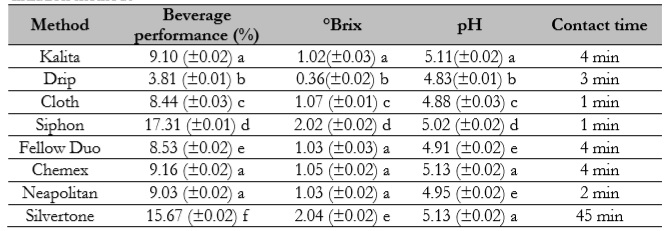
Note. Average values (n = 3) with different letters in the same column indicate statistical differences at a significance level of 5 % (p < 0.05).
Source: Elaborated by the authors.
Beverage performance (%) was highest with the Siphon method, followed by Silvertone. The Siphon method may have performed better, owing to the vacuum pressure created within the apparatus. It causes hot water to rise to the coffee for infusion, thus efficiently extracting both soluble and insoluble solids. The Silvertone method consists of a metallic filter with multiple holes that facilitate extraction and prolonged contact time. In contrast, those methods that employ filter paper, such as the Kalita, Chemex, and Drip methods, failed to perform at the same level. The method with the lowest coffee beverage performance was the Drip coffee maker, with a significant decrease in bean utilization. The methods with the highest performance showed greater beverage darkening as a result of solid concentration. All the methods evaluated in this study involved hot water, hoping to enhance solubility, although specific filter characteristics impeded the transfer of mass during the lixiviation process. The ANOVA indicated a significant difference between the preparation method applied and the performance obtained (p < 0.05).
Coffee preparation methods with the highest concentrations of soluble solids (°Brix) were Siphon and Silvertone, which also had high beverage performance. The coffee prepared via the Drip method had lower-than-expected °Brix values. These results are closely related to the performance of the beverage obtained from each of the gravity-filtration methods studied. Filter manufacture materials varied and, in this case, included cloth (Siphon, Cloth), paper filters with different degrees of porosity (Kalita, Drip, and Chemex), and stainless-steel filters (Fellow Duo, Neapolitan, and Silvertone). These results indicated that the preparations influenced the dilution of organic acids, sugars, salts, and other water-soluble compounds. Silvertone and Siphon were the methods with the best performance. Economically, the commercialization of beverages prepared with these methods is profitable; excellent extraction is obtained during preparation at nearly the values obtained with pressure-filtration methods Presso and Expresso (Ormaza- Zapata et al., 2019). The statistical analysis showed the significant effect of preparation methods on the soluble solids concentrations (p > 0.05) of those beverages prepared.
The preparation methods with the highest pH levels were Chemex, Silvertone, and Kalita. Those with the lowest pH levels were the Drip and Cloth methods. The Siphon, Fellow Duo, and Neapolitan methods had similar pH values. There was no agitation with the Chemex, Silvertone, and Kalita methods, which may not have permitted the complete solubilization of organic acids present in the coffee and resulted in beverages with less acidity than the other preparations evaluated. With the Drip method, significant turbulence might have been generated by the hot water, which helped to mix it with the coffee and resulted in its low pH level. Only with the Siphon and Neapolitan methods was direct agitation of the mixture present. The pH values for the prepared beverages oscillated between 4.83 and 5.13 (Table 1), with a roasting temperature of 180 °C. Liu et al. (2021) indicated a broader pH range (4.90–5.80) in their coffee preparations, oafter highly intense roasting processes, above 230 °C. The organic acids in coffee (trigonelline, caffeine, and chlorogenic acids, among others) directly influence pH value and the perception of acidity in the cup test, based upon the roasting and preparation types employed (Budryn et al., 2015; De Luca et al., 2016). The ANOVA indicated a significant difference (p > 0.05) between beverage pHs and preparation methods in the eight methods analyzed.
The concentration of total phenols was most significant with the Chemex method, followed by the Siphon and Silvertone methods, with 8545.9, 2449.1, and 2423.7 mg of gallic acid/100 g of sample, respectively (figure 2). The Chemex method presented a phenol content three times higher than that registered with the Siphon method. In descending order, the lowest phenol contents were obtained with the Kalita and Drip methods. The Cloth filtration, Fellow Duo, and Neapolitan methods showed similar intermediate total phenol concentration values. The preparation method significantly affected (p < 0.05) total phenol retention. The preparation method with the poorest performance was Drip, which also had the lowest total phenol concentration. Chemex performed poorly but had high total phenol content. The mass transfer barrier that certain filters presented, given their material, porosities, and permeability, may have influenced this. Most gravity-filtration methods had performances below 10 %, except for the Siphon and Silvertone methods.
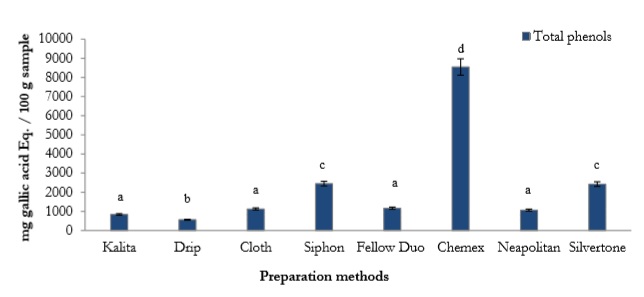
Source: Elaborated by the authors.
Figure 2 Total phenol concentration with gravity-filtration coffee preparation methods
Fonseca-Garcia et al. (2014) found that the total phenol content in commercial samples from northern Santander ranged between 1,129 and 2,582 mg of gallic acid eq./100 g of coffee, coinciding with total phenol content reported in the present study for beverages prepared with the Siphon, Fellow Duo, Neapolitan, and Silvertone methods. In one previous study, Expresso coffee registered total phenol content of 5,000 mg of gallic acid eq./100 g of sample, which is lower than that obtained herein for the beverage prepared with Chemex. It which had a total phenol content higher than the Expresso with an average total phenol content of 8,545.9 mg of gallic acid eq./100 g of sample (Ormaza-Zapata et al., 2019).
According to various authors, phenolic compounds are responsible for the antioxidant activity in coffee (De Abreu Pinheiro et al., 2021; Muñoz et al., 2020; Rao & Fuller, 2018). Roasting frees caffeine, owing to phenol thermal degradation, which generates a fuller body and the bitter taste characteristic of coffee beverages (Cheng et al., 2016; Swak et al., 2017). Further, the ingestion of phenolic compounds in the diet protects the body from critical chronic illnesses (Mussatto, 2015).
The Chemex method reflected high flavonoid concentrations, followed in descending order by the Silvertone and Siphon methods, with 13,223.9, 2,794.6, and 2,578.2 mg, respectively, expressed in mg of catechin equivalent to 100 g of sample, as indicated in figure 3. Note that the flavonoid content retained in Chemex coffee was 4.7 times greater than that obtained with Silvertone coffee. In descending order, the flavonoid content was lowest with the Cloth, Neapolitan, Fellow Duo, Kalita, and Drip methods. The preparation method showed a significant effect (p < 0.05) on flavonoid retention in the beverages obtained. Vega et al. (2017) indicate that Panamanian commercial samples of roasted, ground coffee had total flavonoid concentrations between 220.16 and 380.29 mg catechin eq./100 g of different varieties of coffees, including Arabica and Geisha. These results are far below the findings of the present study, even though the authors diluted 5 g of roasted, ground coffee in 100 mL at 90 °C.
As with total phenols, flavonoids contribute to preventing terminal and chronic illnesses (Chen & Chen, 2013; Kurzawa-Zegota et al., 2012). Additionally, their continuous consumption may help reduce the incidence of coronary and intestinal illnesses (Cardona et al., 2013).
As related to tannin retention in the beverages prepared with different gravity-filtration methods, as shown in figure 4, concentrations were most significant with the Silvertone method, followed by Siphon and Neapolitan, with 147.9, 140.6, and 88.2 mg, respectively, expressed as mg of catechin eq./100 g of sample. The methods that registered the lowest tannin content, in descending order, were Kalita, Fellow Duo, Cloth, Chemex, and Drip. The statistical analysis indicated a significant difference (p < 0.05) in condensed tannin concentrations regarding beverage preparation methods.
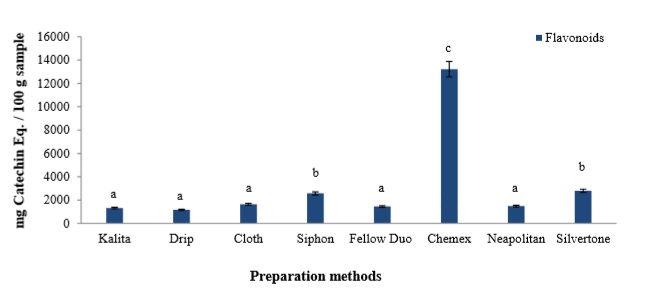
Elaborated by the authors.
Figure 3 Flavonoid content with gravity-filtration coffee preparation methods.
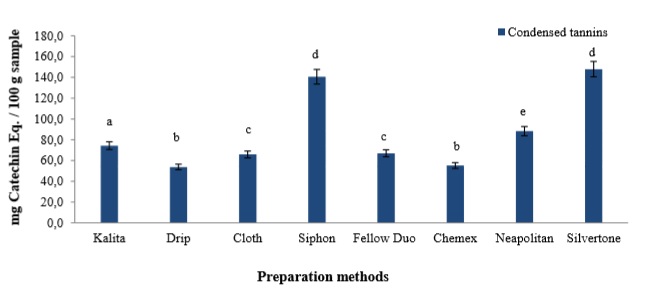
Source: Elaborated by the authors.
Figure 4 Condensed tannin concentrations in gravity-filtration preparation methods
Tannin concentrations in coffee beverages are related to astringent notes, which may affect cup tests, as these are characterized by constriction, puckering, and dryness in the mouth cavity mucosa. They also influence the sensation of the bitterness of coffee-based beverages (Caetano et al., 2017; Chira & Teissedre, 2015; Watrelot et al., 2018). Following Díaz-Arango et al. (2018), tannins increase in concentration with the length of the roasting process, using Coffea arabica L. var. Castillo coffee samples and a roasting temperature of 180 °C. Per the cup profile obtained, the astringent notes in the beverages evaluated were within the optimal range (53.7 to 147.9 mg of catechin eq./100 g of sample; Figure 4), given that tannin concentrations were not representative of the QDA profile score and earned scores similar to the Excelso pattern.
Tannins have anti-bacterial, anti-hemorrhagic, and anti-inflammatory properties on a biofunctional level. Their contribution to improvements in the intestinal health of pigs has further been confirmed by live tests (Caprarulo et al., 2021).
The hydroxycinnamic acid content in those beverages prepared via the eight gravity-filtration methods evaluated are shown in figure 5. Chlorogenic acid content was highest with the Siphon method, followed by the Neapolitan and Fellow Duo methods. Caffeic acid was only detected with the Drip method, possibly because the operating temperature of this method was the lowest and this preserved this hydroxycinnamic acid in the drink obtained. In the remaining methods studied the compound was not identified. .-coumaric acid content was highest with the Siphon method, followed by the Fellow Duo and Neapolitan methods, which had similar concentrations of this compound. In descending order, ferulic acid reflected its highest concentrations with the Siphon, Fellow Duo, and Neapolitan methods and low content with the Kalita and Cloth methods. Only the Drip method contained all four of the hydroxycinnamic acids analyzed due to low operating temperature and short coffee-water contact time. The Cloth filtration method had the lowest concentrations of all the hydroxycinnamic acids evaluated. The ANOVA indicated a significant effect (p < 0.05) of preparation methods on the concentrations of hydroxycinnamic acids in the beverages obtained.
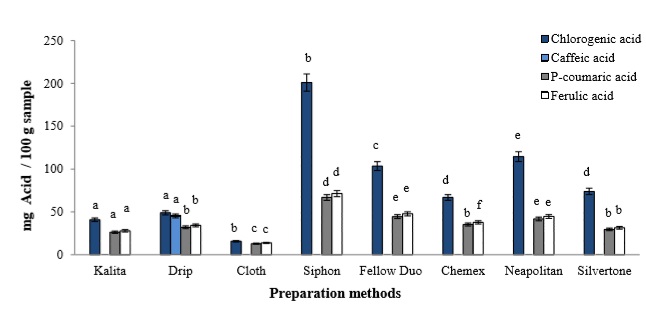
Source: Elaborated by the authors.
Figure 5 The hydroxycinnamic phenolic acid content in beverages prepared with gravity- filtration methods.
Hydroxycinnamic acids influence the sensorial perception of beverages in terms of antioxidant activity, as do chlorogenic acids, which provide acidity, astringency, and bitter notes to the beverage. Thus, it is crucial to indicate the part of the chlorogenic acid that degrades during roasting (59.7% to 98 %). However, they can still act as precursors to flavor in the final coffee infusion (Cheng et al., 2016).
In the comparison of hydroxycinnamic acid content quantified in the gravity-filtration methods (chlorogenic, caffeic, p-coumaric, and ferulic acids) with other types of preparations reported in previous studies, we found that they coincide in a range between 20 and 120 mg/100 g of sample, approximately (Angeloni et al., 2019; Muñoz et al., 2020). Muñoz et al. (2020) reported lower concentrations of chlorogenic acid in Colombian coffee samples (C. arabica) compared to those obtained with the Siphon, Fellow Duo, Chemex, Neapolitan, and Silvertone methods.
Those values obtained for antioxidant capacity with the ABTS, ORAC, and FRAP methods were statistically different (p < 0.05) (figures 6 and 7, respectively). ABTS activity values in descending order were registered with the Silvertone, Siphon, Neapolitan, Chemex, Cloth, Fellow Duo, Kalita, and Drip methods. With the ORAC method, antioxidant capacities were obtained, in descending order, for the Silvertone, Neapolitan, Cloth, Fellow Duo, Chemex, Kalita, and Drip methods. In terms of the FRAP method, in descending order, were the Silvertone, Siphon, Neapolitan, Cloth, Fellow Duo, Chemex, Kalita, and Drip methods. These results indicated a positive correlation in the expression of antioxidant compounds in the coffee beverages ready for consumption. The Kalita and Drip applications had the lowest antioxidant capacities registered with the ABTS, ORAC, and FRAP methodologies. The Silvertone, Siphon, and Neapolitan methods presented more significant activity than the Chemex method in the three methodologies evaluated to determine antioxidant activity in the beverages. However, Chemex did have the highest concentration of total phenols and flavonoids, except for condensed tannin and hydroxycinnamic acid content. The Siphon and Silvertone methods showed the best beverage performances compared to the other six methods studied. In this sense, antioxidant activity is more relevant to the antioxidant content present in beverages.
The Neapolitan method presents ABTS activity which coincides with that reported by Caporaso et al. (2014), which was lower than that analyzed for the Moka and Expresso methods in Arabica coffee samples in the same conditions.
One study performed on Colombian coffee (C. arabica), in which FRAP and ABTS antioxidant activity was measured, found that the magnitude of these determinations was similar (Muñoz et al., 2020) but did not coincide with the present study, as FRAP activity showed values lower than those obtained for ORAC and ABTS antioxidant activity.
As concerns the antioxidant content and activity of coffee-based beverages, said expression is in line with factors including grind size, coffee-water relationship, water temperature, and extraction time of the method used (Niseteo et al., 2012).
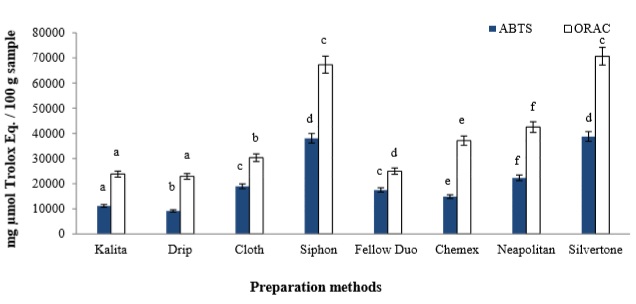
Source: Elaborated by the authors.
Figure 6 Antioxidant capacity for the ABTS and ORAC methods in beverages prepared with gravity-filtration methods.
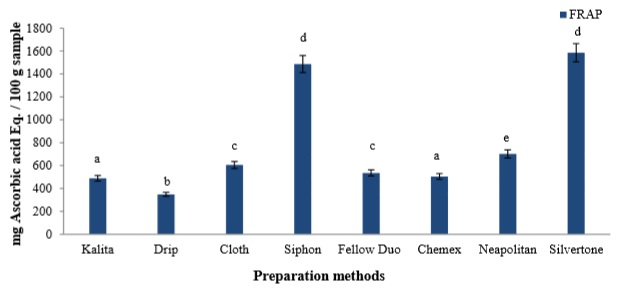
Source: Elaborated by the authors.
Figure 7 FRAP antioxidant activity measured in coffee beverages prepared via gravity-filtration methods.
However, the viability of the three methodologies employed in the present study was demonstrated in measuring the antioxidant activity of coffee beverages prepared with these gravity-filtration methods, as they had a direct correlation (figures 6 and 7).
The scores are given for beverages prepared via eight gravity-filtration methods (figure 8), with different profiles compared to the UGQ pattern. The latter indicated that the preparation method applied influenced the cup profile of Excelso coffee (UGQ). The statistical analysis determined that there were significant differences (p < 0.05) between the coffee preparation method and the sensorial profile of the cup obtained (indicated with letters in superscript in the caption to Figure 8). Beverages with profiles identical to the UGQ pattern were prepared with the Kalita and Fellow Duo methods. Beverages prepared with the Chemex, Siphon, and Neapolitan methods had higher levels of acidity (score of 5), while the Silvertone method scored poorly for this attribute (score of 4). The beverage prepared with the cloth filter had the lowest score in acceptance (score of 6) and high levels of residual flavor (score of 3). The preparation with the fullest body was made with the Silvertone method (score of 7). Preparations with the lightest body were prepared with the Drip coffee maker and Neapolitan methods (scores of 6.5 and 7, respectively).
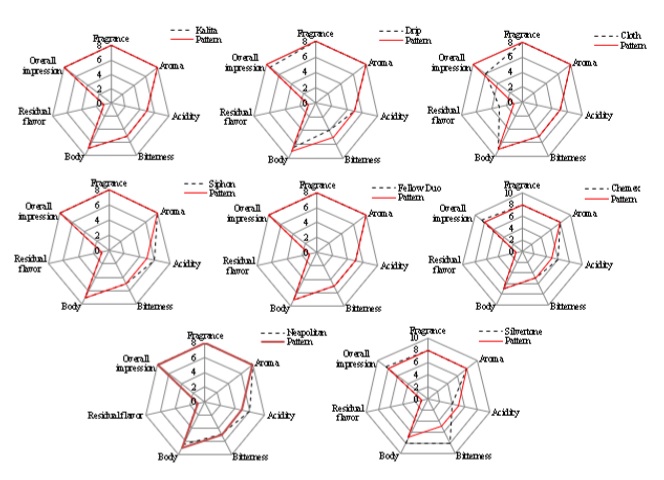
Source: Elaborated by the authors.
Figure 8 The sensorial profile of beverages prepared with the gravity-filtration principle: Kalitaa, Dripb, Clothc, Siphond, Fellow Duoa, Chemexe, Neapolitanf, and Silvertoneg, compared to a UGQ pattern. Average values (n = 3).
The method with the highest score in bitterness was Silvertone (score of 8). The coffee prepared with the Drip coffee maker had a bitter tone (score of 4). The remaining preparation methods had notes like that of the Excelso pattern. Silvertone coffee was among the three preparations with the greatest total phenol and flavonoid content, metabolites responsible for providing bitter flavor to coffee beverages (score of 8). Similarly, the Silvertone method obtained high extraction performance and presented one of the highest scores in the overall impression attribute (score of 8.2), together with the Chemex preparation (score of 8.2). The preparation methods that varied most negatively from the UGQ pattern were the Drip and Cloth methods, regarding body (score of 7), overall impression (score of 8), aftertaste (score of 1), and bitterness (scores of 4 and 5, respectively) attributes. In terms of the tannin concentration indicated in Figure 4, said concentrations were low and of little significance to the cup profile, given that no taster indicated undesirable astringent notes in the preparations studied.
The manufacturers of the Fellow Duo method mentioned that the beverage obtained with this method has a full body without over-extraction (Fellow, 2021). However, the same body as the UGQ pattern was obtained in the results. As indicated by the manufacturers of the Neapolitan method (Illy, 2017), the coffee obtained in this study had a thin body and full flavor, with more excellent acidity than bitter flavor. Following the Chemex preparation principle, the container shape permitted the obtention of a more extraordinary aroma and a cup with low residuality and without coffee stains. Further, the Chemex filter is 20-30 % denser to retain coffee oils and prevent the passing of insolubles through the Chemex filter and enjoy a clean cup (Solano, 2016). In terms of the present study, Chemex coffee had high acceptance levels. The Silvertone preparation was characterized as a beverage with a full body, rich in sediments and bitterness, which were confirmed by the present study. As a vacuum-type preparation given its principle, the Siphon method provides the beverage with a balance and highlights the fruity and aromatic flavors of the cup. Additionally, the minimal contact with oxygen during its preparation may favor antioxidant retention and expression.
Conclusions
The gravity-filtration preparation methods, beginning with Chemex, followed by Siphon and Silvertone, presented significant antioxidant compounds, including total phenols and flavonoids. In descending order, the condensed tannin concentration was highest in Silvertone, Siphon, and Neapolitan coffees, and the Silvertone, Siphon, and Neapolitan methods registered the highest antioxidant capacity, following the ABTS, ORAC, and FRAP methodologies. In descending order, the hydroxycinnamic acid content was highest with the Siphon and Neapolitan methods. In the cup profile of the evaluated methods, Silvertone coffee reached the highest score for bitter notes, surpassing the UGQ pattern. The preparation methods with the highest overall impression scores were Silvertone and Chemex. The Cloth filter method obtained the lowest QDA profile score. We thus recommend that coffee-based beverages be prepared with the Silvertone, Siphon, or Neapolitan methods to guarantee high consumption of antioxidant compounds with the highest antioxidant capacities. Should the consumer prefer bitter beverages, Silvertone coffee consumption is the best choice. In the opposite case, coffee prepared with the Siphon and Neapolitan methods, which had marked acidic notes, is advised.














